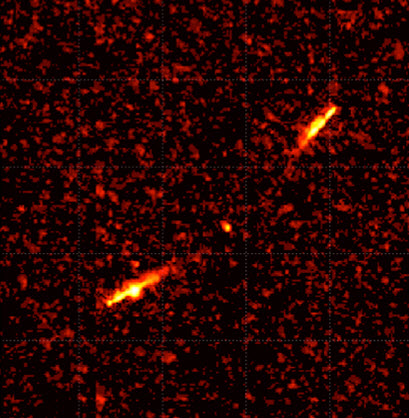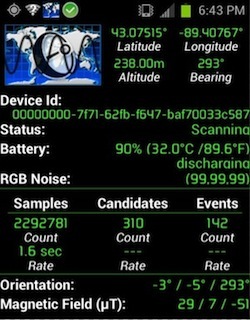How to turn your Android phone into a cosmic ray detector
October 7, 2014

Cell-phone-camera image showing evidence of an energetic-particle hit (surrounded by sensor noise) (credit: Justin Vandenbroucke)
An Android app (iPhone app planned) that transforms your cell phone into a cosmic-ray particle detector has been created by Justin Vandenbroucke, a University of Wisconsin-Madison assistant professor of physics and a researcher at the Wisconsin IceCube Particle Astrophysics Center (WIPAC).
“It uses the same principles as these very large experiments,” he says.
Cosmic rays are energetic subatomic particles created, scientists think, in cosmic accelerators like black holes and exploding stars. When the particles crash into the Earth’s atmosphere, they create showers of secondary particles called muons*.
Smartphone cameras contain silicon-chip sensors that use the photoelectric effect (when photons hit a silicon surface they release an electric charge). The same is true for muons: When a muon strikes the sensor, it liberates an electric charge and creates a signature in pixels that can be logged, stored, and analyzed.
Referring to the image above, “this is an especially interesting event because we don’t know exactly what it is, but the pattern of three light deposits is unusual and intriguing,” Vandenbroucke told KurzweilAI. “It could very well be the result of a radioactive decay (trace amounts of Uranium and Thorium that are all around us produce energetic particles that we can detect, in addition to the cosmic-ray events).”
How to capture muons

A screen capture of data from the DECO app, such as the number of cosmic events recorded (credit: Justin Vandenbroucke)
Here’s how to get started.
1. Download the DECO app (stands for Distributed Electronic Cosmic-ray Observatory) and data logger.
2. Cover the phone’s camera lens with black electrician’s tape and place the phone screen-up just about anywhere, even in a desk drawer — muons can penetrate matter much like X-rays (but are absorbed by the Earth, so we only detect down-going ones from the sky, Vandenbroucke adds).
Muon detectors are used, for example, to find hidden geological features and buried structures of archaeological interest.
3. DECO takes a camera image every couple of seconds. The DECO app analyzes the image and if enough pixels light up, it gets recorded as an event and the logger uploads it (along with time, location, and other data) to a central database for analysis**. Radioactivity in the environment can also be recorded.
Vandenbroucke validated the smartphone cosmic ray detector by setting it up and logging data on long-distance commercial airline flights. Muons are more easily detectable at high altitudes, so he would plug in the detector and switch it on once the flight reached cruising altitude.
Uses in science and education
Pocket cosmic ray detectors are unlikely to overtake the large, sophisticated detectors astrophysicists use, but if enough people put idle or old cellphones to use to capture muons, the project initiated by Vandenbroucke could one day evolve into a meaningful citizen science project***.
For example, Vandenbroucke says cosmic-ray particle detection events can sometimes be matched (adding locations) to cosmic phenomena detected by other, more sophisticated observatories and experiments.
“We think this is an excellent way for students and interested members of the public to learn about particle physics and astrophysics in a hands-on way,” Vandenbroucke told KurzweilAI. “It may prove to be useful for cosmic ray physicists (like myself) in the future by collecting data from many phones on the ground, or potentially by flying the phones on balloons [piggyback on Google Project Loon?], sounding rockets, or CubeSats to detect the primary cosmic rays directly.
“We are in contact with the Zooniverse group and hope to partner with them in the future to take advantage of their tools for classifying and discussing (in an online forum) the images and analysis.”
To help transform DECO into a potent educational presence, Vandenbroucke’s WIPAC group — with grant support from QuarkNet, a national program in particle physics and teacher professional development — plans to engage high school teachers to develop curricular materials around the use of the smartphone cosmic ray detector. DECO was aided this past semester and summer through the programming skills of recent Janesville Craig High School graduate and WIPAC intern Matthew Plewa.
DECO is supported by grants from the American Physical Society, the Knight Foundation and the Simon-Strauss Foundation.
* “Muons are subatomic particles that are similar to electrons but much heavier,” Vandenbroucke explained to KurzweilAI. “When cosmic rays from outer space (predominantly protons) collide with the Earth’s atmosphere, they produce a cascade of subatomic particles including electrons, positrons (the antimatter version of electrons), and muons. While many of the other particles are absorbed by the atmosphere, muons reach the ground in large numbers. So, of the various particles produced by cosmic rays, it is easiest to detect muons.”
** “You can access data from your own logger,” Vandenbroucke noted in an email update to KurzweilAI. “That is one of the main motivations — that everyone can both generate and analyze the data. Currently, this requires some computer savvy, to query a database. But we are working on a more accessible web-based interface.”
*** What about the effects of cosmic ray particles on computer chips (aside from camera sensors)? A 2005 IEEE presentation, How Cosmic Rays Cause Computer Downtime, lays out the problem and possible solutions. And Intel was awarded a patent in 2007 for “Cosmic ray detectors for integrated circuit chips.” Maybe a future version of DECO could provide useful data for that purpose too?
UPDATE Oct. 7, 2014 — Footnote on accessing a logger and clarification on muon blocking by the Earth added, based on email from Vandenbroucke. Also, a modification from him to the caption and the text regarding a possible source of the visual anomaly in the figure.